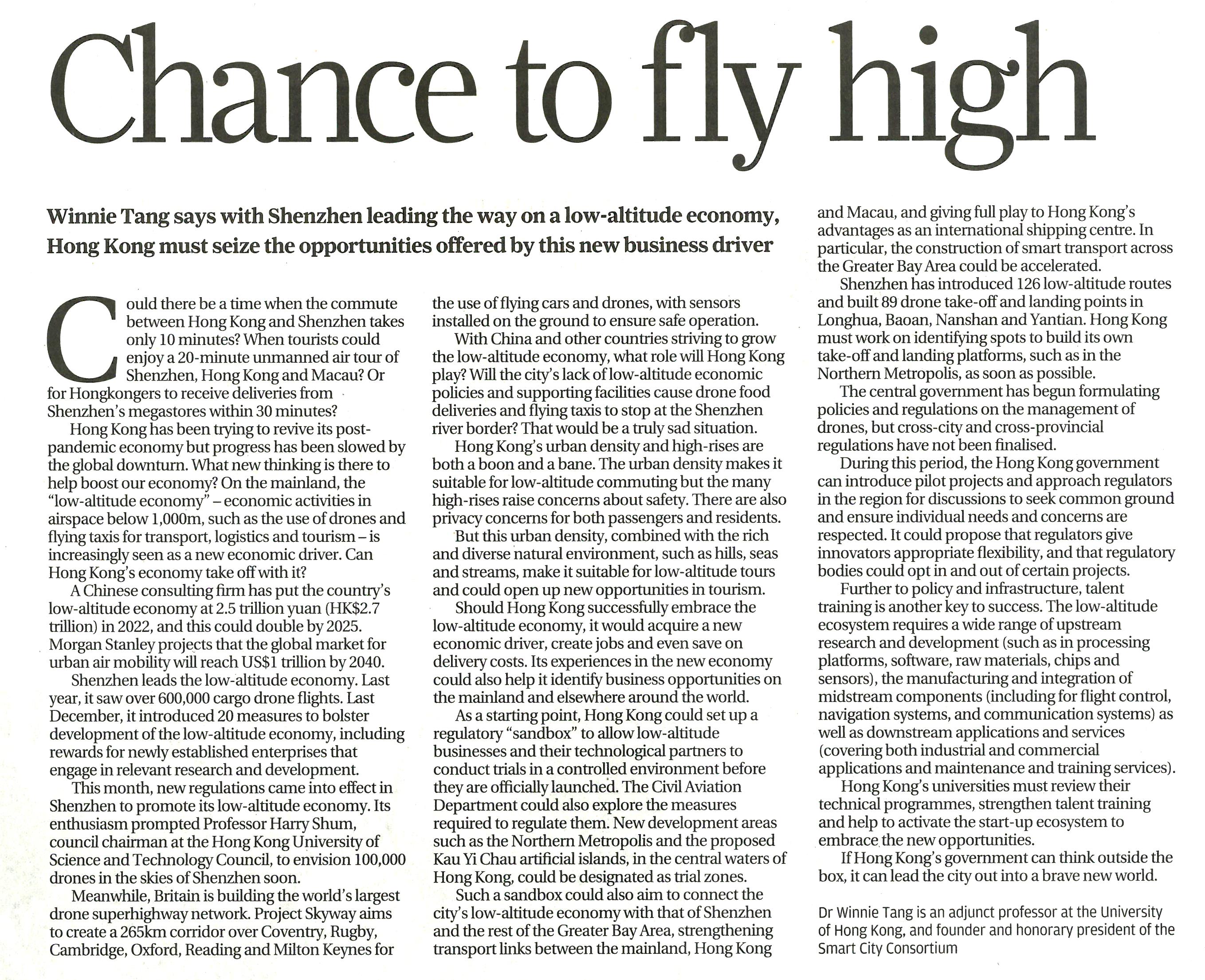網上版請按此

Chance to fly high
Winnie Tang says with Shenzhen leading the way on a low-altitude economy, Hong Kong must seize the opportunities offered by this new business driver
Could there be a time when the commute between Hong Kong and Shenzhen takes only 10 minutes? When tourists could enjoy a 20-minute unmanned air tour of Shenzhen, Hong Kong and Macau? Or for Hongkongers to receive deliveries from Shenzhen's megastores within 30 minutes?
Hong Kong has been trying to revive its post-pandemic economy but progress has been slowed by the global downturn. What new thinking is there to help boost our economy? On the mainland, the "low-altitude economy" – economic activities in airspace below 1,000m, such as the use of drones and flying taxis for transport, logistics and tourism – is increasingly seen as a new economic driver. Can Hong Kong’s economy take off with it?
A Chinese consulting firm has put the country's low-altitude economy at 2.5 trillion yuan (HK$2.7 trillion) in 2022, and this could double by 2025. Morgan Stanley projects that the global market for urban air mobility will reach US$1 trillion by 2040.
Shenzhen leads the low-altitude economy. Last year, it saw over 600,000 cargo drone flights. Last December, it introduced 20 measures to bolster development of the low-altitude economy, including rewards for newly established enterprises that engage in relevant research and development.
This month, new regulations came into effect in Shenzhen to promote its low-altitude economy. Its enthusiasm prompted Professor Harry Shum, council chairman at the Hong Kong University of Science and Technology Council, to envision 100,000 drones in the skies of Shenzhen soon.
Meanwhile, Britain is building the world's largest drone superhighway network. Project Skyway aims to create a 265km corridor over Coventry, Rugby, Cambridge, Oxford, Reading and Milton Keynes for the use of flying cars and drones, with sensors installed on the ground to ensure safe operation.
With China and other countries striving to grow the low-altitude economy, what role will Hong Kong play? Will the city's lack of low-altitude economic policies and supporting facilities cause drone food deliveries and flying taxis to stop at the Shenzhen river border? That would be a truly sad situation.
Hong Kong's urban density and high-rises are both a boon and a bane. The urban density makes it suitable for low-altitude commuting but the many high-rises raise concerns about safety. There are also privacy concerns for both passengers and residents.
But this urban density, combined with the rich and diverse natural environment, such as hills, seas and streams, make it suitable for low-altitude tours and could open up new opportunities in tourism.
Should Hong Kong successfully embrace the low-altitude economy, it would acquire a new economic driver, create jobs and even save on delivery costs. Its experiences in the new economy could also help it identify business opportunities on the mainland and elsewhere around the world.
As a starting point, Hong Kong could set up a regulatory "sandbox" to allow low-altitude businesses and their technological partners to conduct trials in a controlled environment before they are officially launched. The Civil Aviation Department could also explore the measures required to regulate them. New development areas such as the Northern Metropolis and the proposed Kau Yi Chau artificial islands, in the central waters of Hong Kong, could be designated as trial zones.
Such a sandbox could also aim to connect the city's low-altitude economy with that of Shenzhen and the rest of the Greater Bay Area, strengthening transport links between the mainland, Hong Kong and Macau, and giving full play to Hong Kong's advantages as an international shipping centre. In particular, the construction of smart transport across the Greater Bay Area could be accelerated.
Shenzhen has introduced 126 low-altitude routes and built 89 drone take-off and landing points in Longhua, Baoan, Nanshan and Yantian. Hong Kong must work on identifying spots to build its own take-off and landing platforms, such as in the Northern Metropolis, as soon as possible.
The central government has begun formulating policies and regulations on the management of drones, but cross-city and cross-provincial regulations have not been finalised.
During this period, the Hong Kong government can introduce pilot projects and approach regulators in the region for discussions to seek common ground and ensure individual needs and concerns are respected. It could propose that regulators give innovators appropriate flexibility, and that regulatory bodies could opt in and out of certain projects.
Further to policy and infrastructure, talent training is another key to success. The low-altitude ecosystem requires a wide range of upstream research and development (such as in processing platforms, software, raw materials, chips and sensors), the manufacturing and integration of midstream components (including for flight control, navigation systems, and communication systems) as well as downstream applications and services (covering both industrial and commercial applications and maintenance and training services).
Hong Kong's universities must review their technical programmes, strengthen talent training and help to activate the start-up ecosystem to embrace the new opportunities.
If Hong Kong's government can think outside the box, it can lead the city out into a brave new world.
Dr. Winnie Tang
Adjunct Professor, Department of Computer Science, Faculty of Engineering; Department of Geography, Faculty of Social Sciences; and Faculty of Architecture, The University of Hong Kong